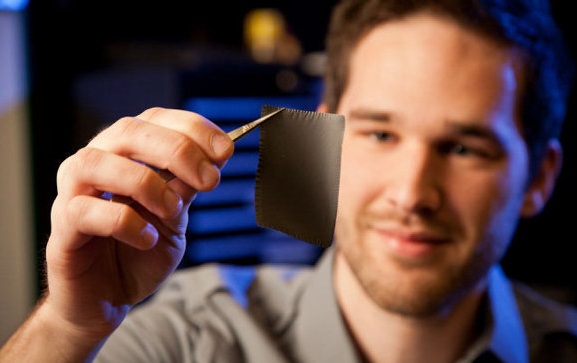You Could Soon Charge Your Gadgets Through Touch Alone With ‘Power Felt’

Imagine being able to charge your energy-sapping smartphone simply by holding it in your palm. Sound implausible? Not according to a team of researchers at Wake Forest University’s Centre for Nanotechnology and Molecular Materials. Led by Professor David Carroll, they’ve developed a new material, named ‘Power Felt’, that can convert wasted body heat into an electrical current.
Imagine the myriad possibilities the material could provide in day-to-day life, and not just in being a replacement to the three-pin mains chargers assigned to our trusted electronics. Theoretically, Power Felt could line roof tiles to convert wasted heat that would otherwise escape through the roof into pennies off your monthly electric bill, be used in clothing to power gadgetry, or even be integrated into children’s toys to put rest fears of ‘batteries not included’.
Made up of tiny carbon nanotubes locked in flexible plastic fibers and tweaked to look like common fabric,  Power Felt creates a charge through significant temperature differences, such as when your warm hand touches a cold(er) mobile phone. As Carroll tells News Observer, “If you grab one end of a bar of metal, the electrons that heat your hand become warm. As they warm, they seek out the cold spots, which would be the other end of the bar. So [the electrons go] rushing down to the other end of the bar. So I have an excess of electrons on one side, and a depletion of excess electrons underneath my hands, so I have a voltage between the two which is called the thermal voltage. And that’s what Power Felt generates.” In principle, Carroll says that Power Felt could even produce an electrical current from what is known as 'mechanical noise' from vibrations in the air around it.
Power Felt creates a charge through significant temperature differences, such as when your warm hand touches a cold(er) mobile phone. As Carroll tells News Observer, “If you grab one end of a bar of metal, the electrons that heat your hand become warm. As they warm, they seek out the cold spots, which would be the other end of the bar. So [the electrons go] rushing down to the other end of the bar. So I have an excess of electrons on one side, and a depletion of excess electrons underneath my hands, so I have a voltage between the two which is called the thermal voltage. And that’s what Power Felt generates.” In principle, Carroll says that Power Felt could even produce an electrical current from what is known as 'mechanical noise' from vibrations in the air around it.
Currently researching ways to add more nanotube layers to the fabric while also making it thinner at the same time to increase power output, the team still has a long way to go. One of the team's chief researchers, graduate student Corey Hewitt, expects research will last at least another couple of years or so, whereby the team will need to continue to up power efficiency in order to grow the demand and ultimately bring down its cost to the consumer.
Richard Birkett
Photo Credit: Ken Bennett - Wake Forest University

